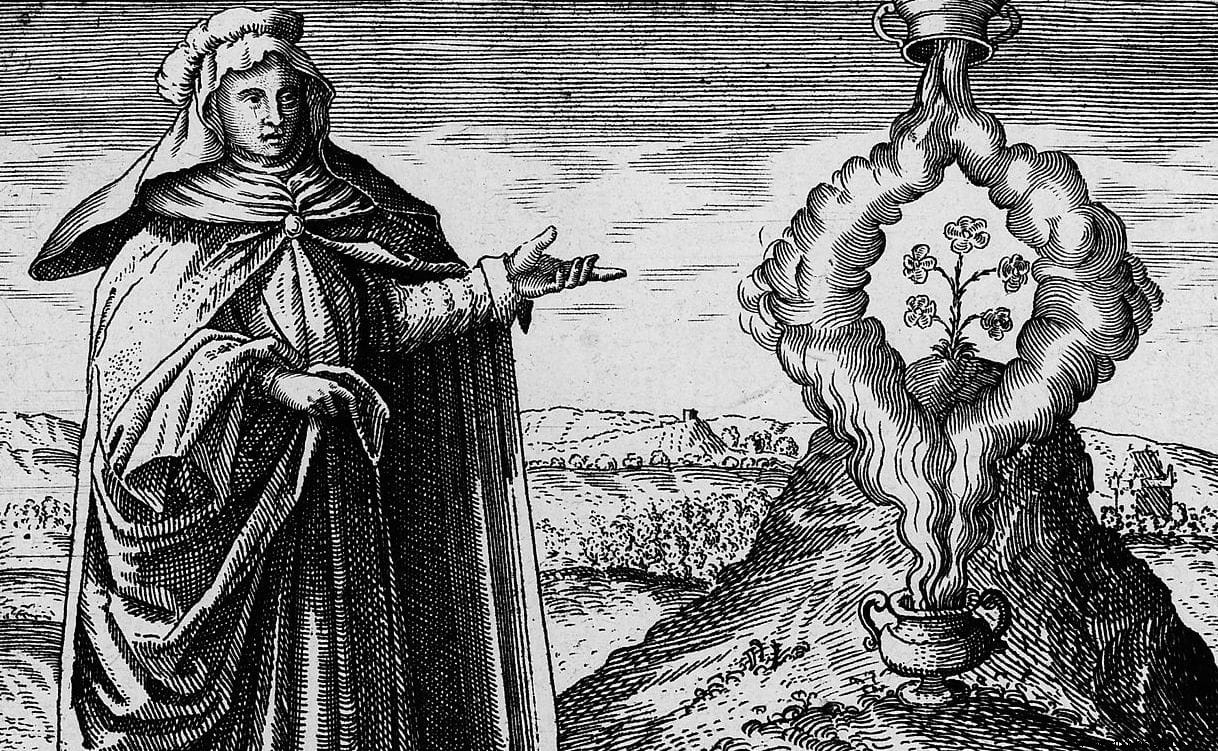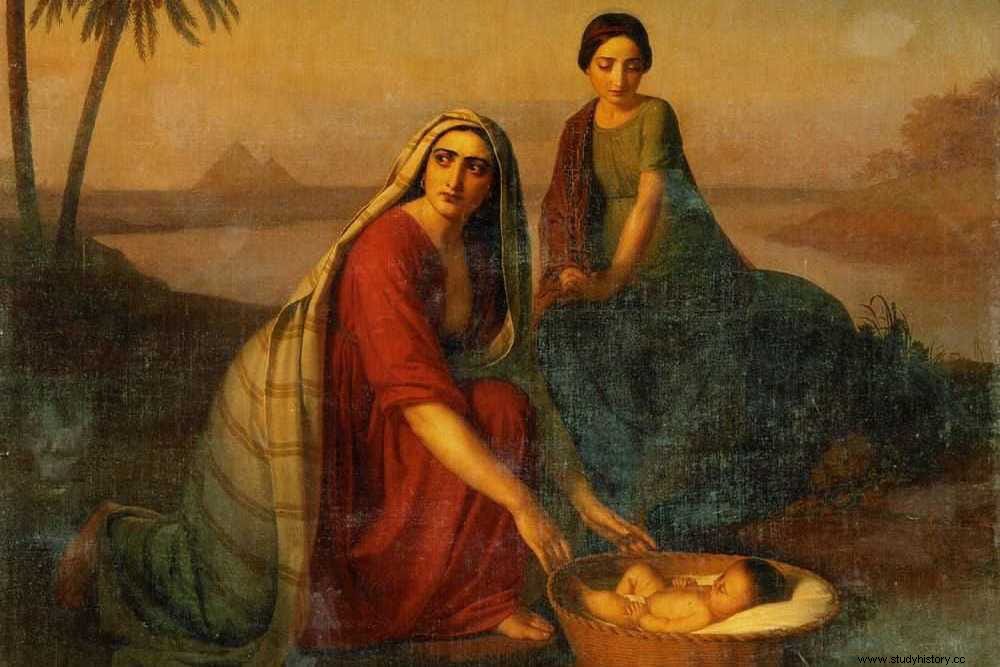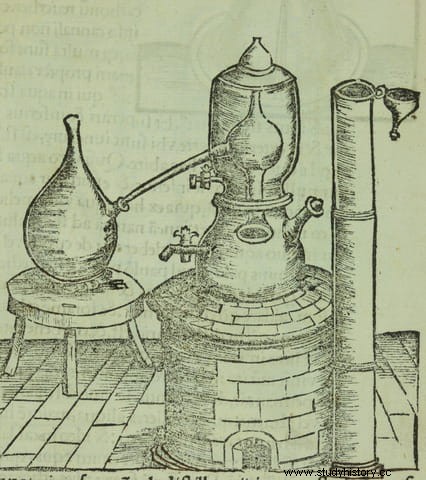To melt chocolate, to liquefy honey, to heat preserves and baby bottles in pre-microwave times, to make desserts and sauces, even to make homemade soap... The bain-marie It is a method whose origins date back to ancient times, not only in the domestic sphere but also in the proto-industrial and scientific spheres, whether in its pharmaceutical or alchemical modality. And, if we listen to any classical author, it was invented by a late-Egyptian woman in the 3rd century AD:Mary the Jewess.
It wasn't actually his creation. That attribution was a mistake made by Zosimus of Panopolis, an alchemist and Gnostic, born in the homonymous city (located in Upper Egypt, current Ajmin) but of Greek descent, famous because in the fourth century AD. he wrote a set of books that are usually collected under the common title of Cheirokmeta ("Things made by hand"), of which loose fragments remain in the Hellenic language or their translations into Arabic and Syrian.
Error, we say, because Zósimo, who made an authentic anthology of other historical practitioners of alchemy (an activity that until the 19th century was considered part of science), cites Mary among those "ancient sages" (alluding to people like Democritus, Moses, Ostanes, Hermes, Isis, Chymes, Agatodemon, Pibechios, Iamblichus, etc.) and assigns the invention to him, ignoring that it had already been described hundreds of years before by the physician Hippocrates and the philosopher Theophrastus, for example. And it is that the figure of Mary was always surrounded by a halo of mystery; there are hardly any verifiable biographical references.

We know that she was born in Alexandria, the famous port city of an Egypt that, in that second century AD. that ventures as the date of her arrival in the world, was part of the Roman Empire (and that some two hundred years later would give birth to another exceptional woman, Hypatia). Nothing else, practically; the rest of the data is limited to her work, since she wrote several books, although none are preserved as they were destroyed by the fire in the library of Alexandria and the persecution against alchemy and sorcery decreed by Diocletian. There are only quotes collected by other hermetic authors, thanks to whom we know something about her research and experimentation.
One of them was the Byzantine Jorge Sincelo, alias the Monk, that as can be deduced he was a priest (the sincere acted as secretary of the patriarch in the Orthodox Church; in the case at hand, said patriarch was Saint Tarasius). He lived, yes, much later, between the end of the 8th century and the beginning of the 9th century AD. Perhaps that is why he must have presupposed a lot, saying in his Eklogué Chronographies that Mary was the teacher of Democritus (the famous Greco-Thracian pre-Socratic philosopher) during his stay in Memphis, something impossible; Democritus was in Egypt for five years, indeed, but six centuries earlier.
Another reviewer is the Arabic Al-Nadim, in whose encyclopedia, Kitāb al-Fihrist , made in the last quarter of the 9th century, adds his name to that of fifty famous alchemists; according to him, he explains, because she knew how to prepare the caput mortuum , the waste substance resulting from a chemical distillation process. A residue of the nigredo, the first phase of the transmutation of matter into gold (the other two were called albedo and rubedo), before its passage to the higher gold-bearing state. It should be added that historically a pigment based on iron oxide was also called that with which dark reddish colors were made, such as Venetian red or cardinal purple; later designated the Egyptian brown color, obtained from mummy dust.
In short, if for the Arabs she was the daughter of Plato and was identified with sulfur -it was customary to associate the alchemist with the substance he used to work-, others supposed that her true identity had to be found in Miriam, the sister of Moses and Aaron; Some even ventured that she was Mary Magdalene herself. Instead, the hermit Morienus, another alchemist rumored to have discovered the philosopher's stone and to have lived in 7th-century Jerusalem, referred to it as "Mary, the prophetess » in his Liber de Compositione Alchimiae , again in relation to Miriam (whom the Exodus , the Talmud and the Torah they call it that).

There is more. Fulcanelli (pseudonym of a 20th-century French author of alchemy books, although there are those who suggest that it is actually a group identity) defines her as “teacher of philosophers” , while the British F. Sherwood Taylor, scientific historian (he was director of the Science Museum in London between 1950 and 1956) specialized in the history of alchemy, breaks a spear in favor of its disputed real existence and also considers it the true discoverer of alchemical practice.
In short, the historicity of the character is not clear; the various hypotheses about the identity of Mary the Jewess , so different from each other, make it seem reasonable to doubt its real existence. However, there are those who do believe in her existence based on the parts collected by third parties from the texts that she left behind. Titles would include:Alumen de Hyspania (a manuscript folio on a type of alum typical of the Iberian Peninsula; it is preserved in Trinity College, Cambridge); Mariae prophetissae de ocultis naturae liber (it is in the Biblioteca Nazionale in Florence); and Les septs visions de Marie la prophetesse sour Louvre de la Pierre des philosophes (Likewise, it's believed to have been done by a medieval alchemist using a pseudonym.)
Her most important work is Dialogue between María and Aros on the teaching of Hermes , aka Excerpts by an Anonymous Christian Philosopher because it was a Christian philosopher of unknown name who copied some fragments. Thanks to them, it is known what the basic operations of alchemy were, in the case of leukosis (whitening), which was done by crushing, and xanthosis (yellowing), carried out by calcination. Likewise, the work describes the use of acid salts and includes recipes for making gold, the opus magnum , including one with a mandrake.

The Dialogue It develops between two characters of Hebrew literature and keeps the style of this, prior to Zósimo, in its metaphorical character. Expressions of the first alchemical stage appear (Hermes, divine water, the four elements of Nature), while others do not (philosopher's stone) and an interpretation of minerals associated with sexual principles is pointed out, so that the union of some would be fruitful against the sterile of others. Experts believe that the author or authors were Jewish alchemists who used the pseudonym of Maria due to the custom of attributing astrological and alchemical themes to characters from the Bible . In any case, this reveals a considerable antiquity of the text.
On the other hand, based on this work, cryptic alchemical precepts are attributed to Mary, such as the union of opposites («Unite the male and the female, and you will find what you are looking for» ) and the axiom that bears her name ( «One becomes two, two become three, and from the third comes one as the fourth» ), which Marie-Louise von Franz, a 20th-century Jungian psychologist who used to interpret fairy tales and inextricable treatises on alchemy, deduced contained metaphors of the feminine principle, the earth, subterranean regions, and evil interpolated between odd numbers of Christian dogma.
Jung himself resorted to the Axiom of Mary to symbolize the process of individuation:one it would be the unconscious totality; two, the conflict of opposites; three, points for possible resolution; the third it is the transcendent function, described as a “psychic function that arises from the tension between the conscious and the unconscious and sustains their union”;
Now, the most outstanding facet of María would be that of an inventor, since she would have devised some of the most important instruments for the practice of alchemy. For example, Zosimo describes for the first time a tribikos and transcribes the description left by Maria herself. It was a three-arm alembic (those with two are called dibikos) , consisting of a clay vessel from which the liquid to be distilled came out through three copper spigots into as many other containers, while a mantera served to condense the steam.

Another creation of his would be thekerotakis , an apparatus that was used to treat some metals with vapors of others (or acids or other substances), with the particularity that its container was closed under vacuum. It was more important than the tribikos in the sense that it was a fundamental tool in alchemical practice and, in fact, it was used for transmutation:María used arsenic, mercury and sulfur to replicate the natural process of underground gold genesis, obtaining an alloy similar in appearance to gold, although the most significant product was the so-called black mary (a paint pigment based on lead and copper sulfide). She never imagined that in 1879 a German named Franz von Soxhlet would use the same concept to invent the homonymous extractor.
However, the most popular and successful invention would have been the bain-marie . We have already said that in reality he was previously known, so the merit of María would be in having involuntarily bequeathed her name to him. This one was given to him by Arnaldo de Vilanova, an Aragonese established in Valencia, the most important doctor in the medieval Latin world, who attended kings and popes, and author of important treatises on medicine, theology and philosophy; Traditionally, alchemy texts were also attributed to him, but it was later concluded that they were not his.
Before being applied to the kitchen, the bain-marie It was used to distill volatile or aromatic substances. And it should be clarified that if it consists of heating a container inside a larger one filled with water, the original method was based on sand and ashes, with which a container was heated, which in turn did the same with another; sand is explained by its ability to resist temperatures higher than water and its ability to maintain heat, as Antonio de las Heras explains in his book Alquimia , it was essential to ensure a continuous supply of heat (a defect would interrupt the process and an excess would spoil it).
Anyway, if Mary the Jewess really existed she was the most important woman alchemist, but not the only one. Others can also be mentioned, such as Madame de Pfuel and her two daughters, who worked for Federico II in the 18th century; or Martine Berteream, wife of the alchemist Jean du Chaterlot, with whom he wrote several mineralogical treatises; Irene Hiller-Erlanger, who was also a poet and was among the favorites of the aforementioned Fulcanelli; Grace Mildmay, practitioner of medical alchemy; and Aemilia Lanyer, Jane Lead, Lucy Hutchinson, etc. A recent study by the European Commission reminds them.
